Presence
journal
special issue on Projection
MIT Press
14.5, October 2005
Two Unusual Projection Spaces
Michael Naimark
Abstract
Two immersive projection enviroments, both unconventional,
both exploring different methods of 3D and panoramic imaging,
and both produced as art installations, are described. Displacements
(1980-1984) re-created an interior living space using a
panoramic motion picture method and relief projection. Be
Now Here (1995-1997) re-created outdoor public plazas using
a panoramic motion picture method, stereopsis, and 4 channel
sound. Both installations were unusual, in that no intentions
existed for anything more general or useful than the installations
themselves as individual artworks.
1. Background
In 1977, I began to wonder why movie cameras move and movie
projectors do not. As a graduate student at MIT's art center,
the Center for Advanced Visual Studies, and like many young
artists, old media was to be questioned and new media was
to be explored. Cinematic forms in particular, ossified
by a giant industry, were ripe for challenge and “expansion,”
and a lively community of proto-media artists was pushing
the boundaries (Youngblood, 1970). Across the street at
MIT’s Architecture Machine Group, for example, a prototype
videodisc player was on its way, and excitement was building
around using this new device for experiments with interactivity.
So it was not unnatural to question such basic tenets as
why movie cameras move and movie projectors do not.
The cheapest, fastest experiment was to mount a super-8
movie camera on a slowly rotating motorized tripod and shoot.
The camera filmed at 18 frames per second (fps) on a small
synchronous motor with a fixed rate of 1 revolution per
second (rpm). Several different focal lengths were used.
After filming, the film was loaded into a small film loop
projector popular in classrooms at the time, and placed
on top of a simple wooden turntable built around the same
1 rpm motor. One of the filmed focal lengths was within
the range of the projector’s zoom lens. (Curiously,
camera lens focal lengths are measured in millimeters and
projector lenses in inches.) The focal length was roughly
matched and the contraption was placed in the center of
a square white room.
With the projector on and the turntable off, the rectangular
movie frame appeared in the center of one of the walls,
projecting a more-or-less conventional panning shot of the
Boston skyline. When the turntable was switched on, something
magical appeared to occur. As the movie frame physically
moved across the walls, the images inside the frame stayed
put, i.e., images of stationary objects such as buildings,
trees, etc., appeared locked in place with respect to the
physical walls. One could, for example, walk up to the image
of the Hancock Building and put one's finger on the image,
and as the frame moved across, the image stayed on the finger.
This effect, a spatial correspondence between the
record space and the playback space, requires that the angular
movements, frame rates, and focal lengths match. Over the
next two years a more elaborate contraption was built to
record the pan and tilt movements of the camera (via a gimbaled
mirror), to drive the pan and tilt movements of the projected
image (Naimark, 1984). I explored this new medium in terms
of form and content and hoped it would be a useful new invention.
The eventual conclusion was: New? Yes. Useful? Not particularly.
These were the days before affordable video projection,
before real-time 3D computer models, and when tracking devices
such as the ones made by Polhemus were wound by hand and
cost $75,000 each. I finally decided that making an artistic
statement was more appropriate than making an impractical
invention.
2. Displacements (1980-1984)
Another form of alternative media I was concurrently exploring
was what is sometimes called relief projection, where an
image is projected on a screen whose shape is the same as
the image. A grotesque but amusing example at the time involved
projecting a movie close-up of a human eye onto a dome-shaped
screen. But the Architecture Machine Group had an interest
in "Transmission of Presence" at that time, and
its Director, Nicholas Negroponte, and I flew down to Orlando
to look at the famous "Talking Head" in Disney
World's Haunted Mansion. A movie of a woman's talking face
was projected onto a mannequin head in such a way that the
eyes, nose, and lips line up. Our hosts at Disney World
allowed us to view it for an extended period from behind
a nearby security curtain. It was clear that as the woman
spoke, the image of her moving lips would mis-register from
the mask-shaped screen, but to most everyone viewing it
briefly from their dark-ride car, this anomaly went unnoticed.
Most people seemed convinced that they had just seen a full
color, moving hologram (which, of course, is nonsense).
Back at "ArcMac," a more elaborate version was
built, whereby the filmed subject’s head movement
could be recorded along with image and sound. Our subject,
Professor Roy Lamson, was filmed using a super-8 sound film
camera and a ($75,000) Polhemus device secured to the back
of his head. A translucent mask of Lamson’s face was
fabricated and mounted in a pan-tilt gimbal (if the truth
be known, the same one built for my projection experiments,
collecting dust). The film was rear-projected onto the face-shaped
mask, which moved in sync with the image. The "Moving
Talking Head," even with the obvious mis-registration
due to the physical motion and filmed movement, was a popular
demo at the time (Negroponte, 1981).
An opportunity to combine relief projection with a simplified
"moving movie" arose for an art exhibition at
the Aspen Center for the Arts called “Beyond Object”
in 1980. The idea was to set up a typical Americana-style
living room on-site, then to film with a motion picture
camera on a slowly rotating turntable from the center of
the space. After filming, a matched projector would replace
the camera on the same turntable and the entire contents
of the room would be secured in place and spray-painted
white, to act as its own projection screen.
A kitschy living room was composed, mostly from thrift shop
finds, including a sofa, easy chair, several tables with
ashtrays and junk food, wall hangings, etc., all situated
around a working television set. Everything was placed against
three walls, and the fourth wall was left blank.
The hardware consisted of a 16mm motion picture camera crystal
synchronized to record at 24 fps, a custom-built 1 rpm turntable,
and a 16mm loop projector with a 24 fps synchronous motor.
The camera and projector had near-matching wide-angle lenses
(12.5 mm and 1/2 inch respectively) with an approximately
40-degree horizontal fields of view (FOV).
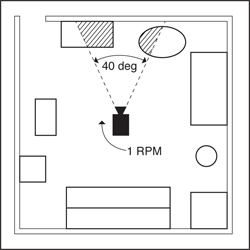
Figure 1: Schematic of camera and projection system.

Figure 2: Spray-painting everything white to become projection
screens.
The installation, obediently entitled "Moving Movie,"
was almost entirely motionless, insofar as the rotating
movie projector simply projected rotating imagery of the
stationary furniture that occupied three of the four walls.
With the direct comparison of subject and image, artifacts
became amplified. For example, the frame rate of 24 fps
was obvious. (Less obvious but noticeable to a careful eye
was that the camera used a single-bladed shutter while the
projector used a twin-bladed shutter.) Focus was an issue,
since the depth of field of the relief projection exceeded
the small depth of field designed into most projectors.
If the rotational synchronization was off by even a single
frame, the mis-registration was obvious. Still, the overall
effect appeared successful.
In what felt like a total violation of the concept, a performer
walked along the fourth blank wall. Though she added some
motion, she appeared simply as a flat projection in an otherwise
3D projection environment.
A similar installation was produced the following year,
with an intention, albeit apprehensive of the "distortional"
effects, to integrate live performers (especially knowing
that they could not be painted white!). This installation,
with another general title, "Movie Room," also
had one blank wall, on which three performers made such
actions as spray-painting graffiti as the camera panned
by. One insisted on sitting on the sofa during filming.
Another snapped a Polaroid picture and stuck it on the blank
wall during filming. I decided, after a great deal of "art
anxiety," to keep the Polaroid picture unpainted. In
the end, I was indebted to the performers. The graffiti
action was striking but safe. The performer on the sofa
appeared nicely ghost-like on top of the "very real"
looking sofa. And the image of the performer holding the
image of the Polaroid, walking toward the actual Polaroid,
and placing it there - witnessing the moment where the image
and object became one - was spine-tingling.
This anomaly was integrated into the third installation,
with little concern about violating the formalism of 3D
representation. Another living room was installed, this
time along all four walls. Lots of movable props were included:
sweaters to take off, a purse, a globe to spin, junk food
on the coffee table. Two performers were carefully scripted
to move things around during filming. Ten different rotations
were filmed. This installation remained a commentary on
the passivity of our old media, challenging them with the
rotating and relief projection, but it was equally about
the anomalies, the displacements. The piece, entitled "Displacements,"
was exhibited in 1984 at the San Francisco Museum of Modern
Art and was final.
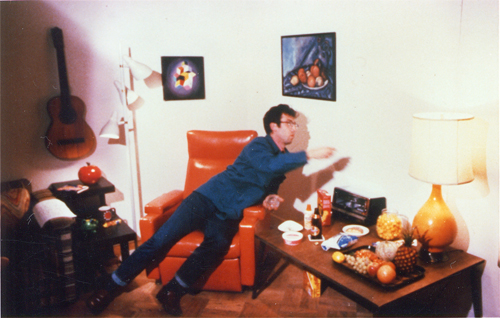 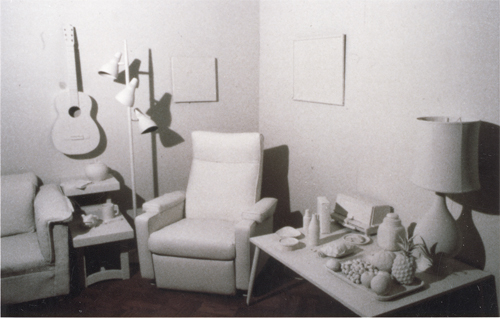 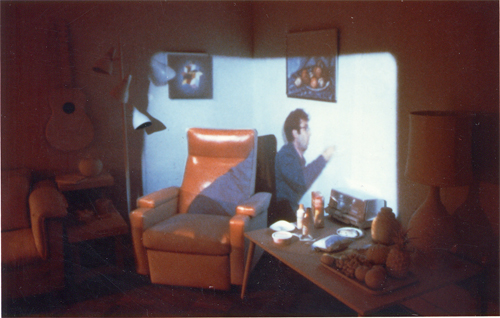
Figures 3, 4, 5: View of Displacements during filming, after
being painted white, and with final projection.
3. Be Now Here (1995-1997)
Eleven years later, I was unknowingly nearing the end of
a two-decade investigation exploring how new media technologies
could expand the range of "place representation."
This investigation followed two parallel tracks: one based
on panoramic or angular "look around," such as
the “moving movie” work above; and the other
based on lateral "move around," such as what came
to be called "moviemaps." In both cases, the work
had increasingly explored filming outdoor landscapes for
immersive, sometimes interactive, art installations. I had
just finished an immersive moviemap installation filmed
with side-by-side cameras for stereopsis, the first-ever
stereoscopic moviemap (Naimark, 1997). It seemed as if the
last unchecked box of an invisible matrix was to make a
stereoscopic motion picture panorama filmed in outdoor landscapes.
I had also become increasingly politicized regarding content.
The innocence and safety of filming along the Charles River
across the street from MIT faded as I filmed more and more
in other places, particularly in other countries. It became
increasingly clear that whoever controls representation,
controls everything (Naimark, 1998).
In 1995, this final project took shape with the support
of Interval Research Corporation and the cooperation of
the UNESCO World Heritage Centre. Interval Research encouraged
arts and media projects, particularly if the results could
stimulate and cross-pollinate other research activities
there. The UNESCO World Heritage Centre, in Paris, designates
sites around the world with extraordinary cultural or natural
value, including a lesser-known list of World Heritage site
"In Danger." At the time, of the 440 designated
World Heritage sites, 17 had been further designated "In
Danger," and four of the 17 were cities: Jerusalem;
Dubrovnik, Croatia; Timbuktu, Mali; and Angkor, Cambodia.
Both spectacular and troubling, these cities would become
the subject of this new project.
The idea was to re-create simply "being" in these
four cities, in public plazas that best represents them.
Specifically, the plan was to work with local collaborators
to find the most representative public plaza in each location,
then to select one spot in each of these plazas from which
to film. The goal was to allow "3D lookaround"
via stereoscopic panoramas.
Stereoscopic panoramas present a curious dilemma. Panoramic
images are two-dimensional by nature, representing a single
point of view. Two side-by-side panoramic images can be
recorded for stereopsis, but the degree of disparity will
change depending on the viewpoint, dropping to zero when
the viewpoint is in line with the two cameras. Disparity
can be kept constant by rotating the cameras about each
other, but then the panoramic images no longer represent
single viewpoints (e.g., circles may become ellipses). A
small but lively community can be found on the Web making
stereoscopic QuickTime VR panoramas by tiling together images
using conventional cameras and living with the disparity
or viewpoint artifacts. These images are usually viewed
in stereo using red/blue anaglyph glasses. Several novel
attempts have been made to build single stereo-panoramic
cameras (e.g., Peleg, 1999).
Two motion picture cameras would be used to record moving
imagery, with the cameras side-by-side for stereo, rotating
on a 1 rpm motorized tripod. The movie could appear to rotate
around the viewers, like the earlier "moving movie"
projects, revealing a panorama over time. John Woodfill,
a computer vision colleague at Interval, proposed rotating
both cameras around the nodal point of one of the cameras.
Rotating about the nodal point of, say, the left camera
would result in a perfect single-viewpoint representation
that could be used for further experimentation. One might
speculate that looking at a stereoscopic panning movie where
one eye sees no disparity and the other eye sees all the
disparity would be noticeable. But one could counter-speculate
that it's possible to sit on a rotating stool with one eye
directly over the axis of rotation and conclude that there's
nothing special about it.
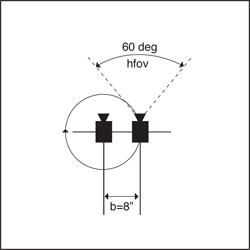
Figure 6: Schematic of Be Now Here camera system.
The camera system was based on two 35mm motion picture cameras,
the kind used in professional movie production. These cameras
have higher spatial resolution and dynamic range than conventional
video cameras and are far more robust under extreme and
remote environments. The cameras were synchronized to run
in phase at 60 fps (rather than the standard 24 fps) and
had variable shutters that could close down to 30 degrees,
resulting in an effective shutter speed of 1/720 second,
fast enough to freeze most everything. High quality Zeiss
lenses were used with very wide-angle 60-degree horizontal
FOVs. Partly for practical reasons, the cameras had to be
mounted with the lenses separated by 8 inches, resulting
in a "hyper-stereo" effect due to the exaggerated
interocular distance. The camera system was, by choice,
approximately 7 feet from the ground. The result would be
a slowly rotating stereoscopic movie with high spatial and
temporal resolutions, an immersively wide FOV, and a viewpoint
resembling a very tall person with a very big head.
The entire system, including cases, weighed 500 pounds but
was built to travel. All production took place in one rather
insane month flying around the world (Naimark, 1995). A
digital audio recorder with a shotgun microphone was used
to collect sounds at each site for later mixing into 4 channel
rotating sound. Enough stock to film 5 panoramas (10 reels
of 400' film) was taken to each site. Miraculously, production
stayed on schedule and everything came out. The film footage
was transferred to videotape, edited, and mastered onto
laserdiscs.
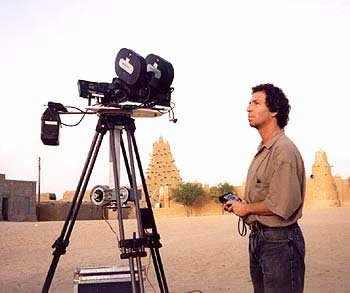
Figure 7: Camera system for Be Now Here during production
in Timbuktu, Mali
For playback, the ideal solution may have been to rotate
the stereoscopic image around the viewers like the previous
moving movies. But in order for the image to appear orthoscopically
correct, the rotating projectors would require 60-degree
horizontal FOVs, far too wide for all but the most exotic
video projectors. The solution, we surmised, was to rotate
the viewers instead. Consider: if the floor on which the
viewers stand rotated in sync with the panning image, and
if the speed was not too fast to be consciously detected
by our vestibular system, and if the rest of the space was
dark enough to minimize other frames of reference, a strong
visceral illusion would result. This illusion would be similar
to the feeling we’ve all experienced when our train
sitting in the station seems to be moving when the adjacent
train pulls out.
The installation, called "Be Now Here," initially
employed a 16 foot diameter 1 rpm rotating floor, a 12 by
16 foot front projection screen capable of maintaining polarity,
four channel surround audio, and a custom-designed input
pedestal allowing viewers to interactively change location
and time of day. The input pedestal was situated in the
center of the floor, from which viewpoint the screen appeared
orthoscopically correct. Two video projectors showed material
from two synchronized, computer-controlled laserdisc players,
and the viewers wore inexpensive polarizing glasses.
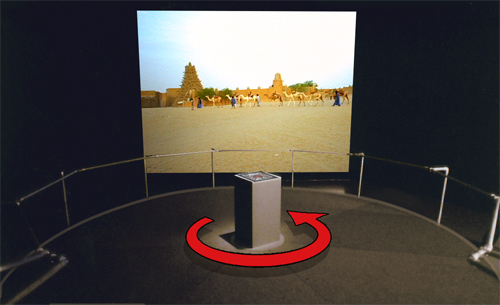
Figure 8: Installation view of Be Now Here.
The overall effect worked, but a small percentage of viewers
complained of vestibular problems, dizziness, from the rotation.
After two public exhibitions, informal tests were made back
at Interval slowing down the floor and motion picture together
to one half and one quarter of the original speed. At half
speed, the "moving train illusion" remained strong
but the dizziness disappeared for most everyone tested,
and at quarter speed, the illusion largely disappeared (Naimark,
1997b). The video was re-edited for half speed and the sound
was re-mixed, resulting in slow motion imagery with real
time surround sound. Incredibly, very few viewers were aware
that the footage was slowed down.
It was also felt that the more visible cues of the actual
(non-rotating) space could be masked, the more effective
the illusion would be. The entire installation was enclosed
with a black cylindrical wall, using a simple cage structure
from which back drapery could be suspended. This modification
required changing from a front screen to a rear screen,
and fortunately for us, an inexpensive, flexible rear screen
material that maintains polarity had recently become available.
The original 12 by 16 foot front screen was replaced by
a 9 by 12 foot rear screen and placed correspondingly closer
to keep the FOV orthoscopically correct, approximately 12
feet from the center of the floor. Now viewers could come
as close as 4 feet to the screen. Surprisingly, few viewers
seemed bothered, or even aware, that their eyes were accommodating
much closer than what would be consistent with the landscape
imagery, and the feeling of immersion remained.
Interval was granted a patent for the Be Now Here immersive
illusion in 1997 (US 5,601,353) and the footage was "mined"
for other research applications. For example, Paul Debevec,
then an Interval intern from UC Berkeley, filmed squares
and cubes covered with checkerboard material, which he and
several other computer vision researchers used to explore
panoramic tiling, background subtraction, and depth from
stereo. Romy Achituv, another Interval intern from NYU,
made a screen-based interactive version of Be Now Here that
combined different times and places into a single panorama
(Achituv, 2000). Students at MIT and UNC also used the footage
for various experiments. Most recently, the footage was
used to simulate what "VR Webcams" might be like
(Naimark, 2002).
Be Now Here continued to exhibit in venues including technical
(Siggraph, 1996, and the Tech Museum of Innovation, 1998),
cinematic (Rotterdam and San Francisco Film Festivals; 1998,
2001), and art (Art at the Anchorage NY, 1997 and Kiasma
Museum of Contemporary Art Helsinki, 2003). But, happily,
it is not without company: a lively community of media artists
continues to push the boundaries of cinematic forms in a
still-ossified giant industry, ripe as ever for challenge
and expansion (Shaw and Weibel, 2003).
4. Discussion
Displacements and Be Now Here share several common features
but also some major differences. Both were attempts to make
immersive virtual environments, particularly using motion
picture media with 3D and panoramic components. Both were
exploring radically different ways of experiencing cinema,
and both had little concern for generalization beyond the
art installations themselves.
The most top-level observation is that the eye is incredibly
difficult to fool. Both installations attempt to make mediated
experiences "just like being there." Both installations
may have looked "more real" than conventional
cinema or television due to higher resolution, proper orthoscopy,
panoramic immersion, and stereopsis, but neither came close
to passing the media equivalent of the Turing Test: "indistinguishable
from the unmediated." (In fact, no visual media, including
3D Imax, can.) This is a sobering lesson for anyone working
in VR.
The level of transparency between the two installations,
i.e., the degree by which the process is visible, was nearly
opposite. Displacements was completely transparent. It was
obvious that the only way to have made it was to have filmed
the room, then painted everything white, then projected
the original film back onto everything. Even children delighted
in reverse-engineering this process. Be Now Here, on the
other hand, was completely opaque. Viewers put on polarized
glasses, then stepped into a completely black room except
for the screen (which, with the glasses, looked more like
a window). They often didn’t realize the floor was
rotating (why would they?). In contrast to the children’s
delight learning the process of Displacements, viewers of
Be Now Here were often confused and sometimes disturbed.
Many reported that the actual feeling of "being there"
was very strong but couldn’t understand why.
Intentionally or not, both installations exploited novelty.
Just as when audiences of the Lumiere’s film of an
oncoming train ducked in 1895, seeing these unusual forms
for the first time caught viewers by surprise. Perhaps if
we were all accustomed to rotating projectors, room-size
relief screens, stereopsis, or rotating floors, the novelty
value of Displacements and Be Now Here would be thin.
But we’re not, and exploring such unusual projection
spaces is potentially boundless, given the range of possibility
that new media technologies afford, with a little unfettered
imagination. To explore these possibilities looking for
something useful, or for a new standard, or to make a fortune,
may miss the richest experiences. These may come under the
province of art, even if sometimes by default.
Acknowledgements
The author gratefully acknowledges that Displacements received
support from the MIT Council for the Arts and the National
Endowment for the Arts, and that Be Now Here received support
from Interval Research Corporation, Palo Alto, and the UNESCO
World Heritage Centre, Paris.
References
Achituv, R. (2000). http://www.gavaligai.com/main/sub/interactive/BNHI/BNHI2.html
, May 2005
Naimark M. (1984). Spatial Correspondence in Motion Picture
Display. SPIE, 462.
Naimark M. (1995). Trip Reports, (self published) http://www.naimark.net/writing/trips/bnhtrip.html
, May 2005
Naimark M. (1997). A 3D Moviemap and a 3D Panorama. SPIE,
3012.
Naimark M. (1997). What’s Wrong with this Picture:
Presence and Abstraction in the Age of Cyberspace. Consciousness
Reframed Proceedings, CAiiA, University of Wales, Newport,
Wales.
Naimark M. (1998). Place Runs Deep: Virtuality, Place, and
Indigenousness. Paper presented at the Virtual Museums Symposium,
Salzburg, Austria. See http://www.naimark.net/writing/salzberg.html
, May 2005
Negroponte, N. (1981). Media Room. Society of Information
Displays, 22 (2).
Peleg, S. and Ben-Ezra, M. (1999), Stereo Panorama with
a Single Camera, CVPR’99.
Shaw, J. and Weibel, P. (Eds.) (2003), Future Cinema: The
Cinematic Imaginary After Film, MIT Press.
Youngblood, G (1970). Expanded Cinema. Dutton.
|